In 1914, the schools of Morgan County, Missouri, participated in a survey of rural conditions. The results were compiled and published in the Missouri State Board of Agriculture Monthly Bulletin, vol. 14, no. 2 (Feb. 1916), with photographs to illustrate the text. The survey covers economic and social conditions in the farming country.
The material in this survey is very interesting for the light it sheds on farm life in Morgan County at the beginning of the twentieth century. The pictures are particularly interesting. Peter Binkley thought it worthwhile to digitize the survey and make it available.
A note on the photographs from Peter Binkley: The original photographs are screened (i.e. made up of dots, like newspaper photographs). To reproduce them on the web, I scanned them at high resolution, blurred them to hide the screening, then resampled them to lower resolution and sharpened them. The results are very faithful to the original. Unfortunately, the copy from which I scanned them was tightly bound, and in some cases it was impossible to avoid having the curve of the page appear in the picture.
[p.1]
MISSOURI STATE BOARD OF AGRICULTURE
MONTHLY BULLETIN
| VOL. XIV. | FEBRUARY, 1916 | No. 2 |
A RURAL SURVEY
OF
MORGAN COUNTY MISSOURI
|
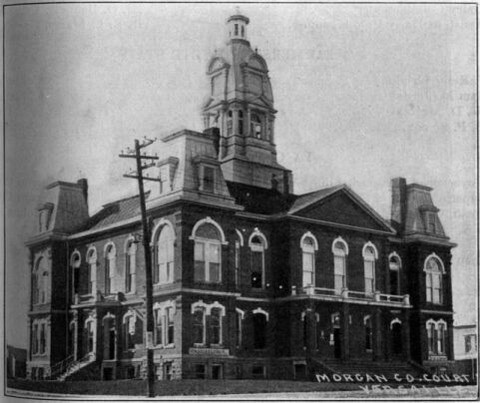 Morgan County Courthouse |
These Bulletins Sent free to Missourians Upon Application to the Secretary of the Missouri State Board of Agriculture 112-124 Agricultural Building, Columbia, Mo.
Published monthly by the Missouri State Board of Agriculture. Entered at the Postoffice at Columbia, Mo., as second-class matter, April 26, 1904.
[p.2]
Missouri State Board of Agriculture
Organized March 13, 1865
COLUMBIA, MO.
OFFICERS
| President | Philander P. Lewis, Crescent |
| Vice-President | W. R. Wilkinson, St. Louis |
| Secretary | Jewell Mayes, Columbia |
| Assistant Secretary | W. L. Nelson, Columbia |
| Treasurer | W. A. Bright, Columbia |
| State Veterinarian | Dr. D. F. Luckey, Columbia |
| Deputy State Veterinarian (at office) | Dr. H. C. Tuck, Columbia |
| Apiary Inspector | M. E. Darby, Springfield |
| Dairy Commissioner | E. O. Bennett, Carthage |
| Assistant Dairy Commissioner | R. E. L. Marrs, Carthage |
FARMERS' INSTITUTE STAFF
| J. Kelly Wright | Columbia |
| Sam M. Jordan | Columbia |
| W. D. McKee | Polo |
| B. P. Smoot | Centralia |
EX OFFICIO MEMBERS
| Governor of Missouri, Elliott W. Major | Jefferson City |
| Superintendent of Schools, Howard A. Gass | Jefferson City |
| Dean, College of Agriculture, F. B. Mumford | Columbia |
CORPORATE MEMBERS
| District. | ||||
| 1. | E. L. Newlon | Lewistown | ||
| 2. | John H. Brayton | Holliday | ||
| 3. | H. C. Duncan | Osborn | ||
| 4. | C. D. Bellows | Maryville | ||
| 5. | T. J. Hedrick | Buckner | ||
| 6. | Mack V. Thralls | Urich | ||
| 7. | George W. Arnold | Sedalia | ||
| 8. | W. A. Dallmeyer | Jefferson City | ||
| 9. | John J. Wakefield | Mexico | ||
| 10. | Philander P. Lewis | Crescent | ||
| 11. | Christ Hilke | St. Louis | ||
| 12. | W. R. Wilkinson | St. Louis | ||
| 13. | E. E. Swink | Farmington | ||
| 14. | R. A. Young | Alton | ||
| 15. | John Parker | Carthage | ||
| 16. | A. T. Nelson | Lebanon | ||
[p.3]
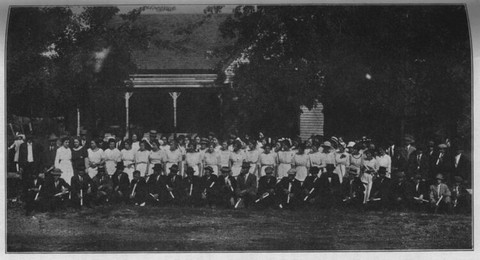
Graduating class, Morgan county rural schools, 1914-1915. Ninety in class.
[p.4]
[This page blank.]
[p.5]
A "DIFFERENT" COUNTRY LIFE SURVEY.
The Missouri State Board of Agriculture herewith presents a "different" country life investigation in the form of a "taking stock" of a county by its own people.
The facts are carefully and thoughtfully edited and presented without effort to arrive at special conclusion, with open mind, frank summing up of a Missouri county.
So far as the writer has seen or read, this bulletin is unique and indeed "different." It may mark a somewhat new departure in country life surveys. No effort is made to conceal or to emphasize any feature of the county—facts as they existed were sought out without fear or favor.
Seldom (if ever) in Missouri have so many individuals had a part and portion in the writing of a localized bulletin, for every district school and so nearly every rural pupil in Morgan county contributed to the gathering of the data and the information.
No partiality was shown in the selection of county, for no other county offered or suggested such a thing, and for two years or more this work has been in contemplation and preparation since Morgan "volunteered."
A vast amount of work—a labor of love—this has been to one and all to whom credit is given in the text. To Mr. W. L. Nelson is due much individual consideration for his large share in the making of this bulletin, which is not simply of Morgan county alone, but rather of country life in Missouri, the "Land of Opportunity" and practical progress.
Does not every county in Missouri need such a bulletin? Does not Missouri need a condensed handbook or bulletin that summarizes and localizes every county truly and correctly, telling what the homeseeker and investor should learn, setting forth the remarkable state opportunities for home building and real estate advancement? Does not Missouri need a bulletin telling how this commonwealth won against the world in international battle for honors at the Panama-Pacific Exposition in San Francisco? Does not Missouri need a bulletin that portrays the beauty, health, opportunity for growing live stock, developing dairy farming, and general agriculture in the Ozarks of this Center State? Does not Missouri need a bulletin setting forth the advantages of using Missouri-mined, Missouri-grown, Missouri-made products? Does not Missouri need a bulletin or bulletins that include directories of the breeders of the sev-
[p.6]
eral lines of pure-bred live stock, that the world may know where and of whom to buy the best that's grown in America?
Again suggesting that you carefully file and keep your copies of this monthly bulletin series, owing to the limited supply printed, please permit the concluding phrase of
 Secretary
Secretary
Missouri State Board of Agriculture,
112-124 Agriculture Building, Columbia, Mo.
[p.7]
A RURAL SURVEY OF MORGAN COUNTY, MISSOURI.
(Edited and compiled by W. L. Nelson, Assistant Secretary Missouri State Board of Agriculture, Columbia, Mo., from information supplied by M. Wray Witten, superintendent public schools, Morgan county, Missouri, and the teachers and pupils of the public schools of Morgan county.)
To Whom Credit is Due.

M. Wray Witten, superintendent public schools, Morgan county, Mo.
Credit for this bulletin, which represents the first effort made in Missouri to secure a rural survey, such survey to be exclusively the work of the people of the county, those actually on the ground and best acquainted with local conditions, is due Prof. M. Wray Witten, superintendent of public schools, Morgan county, Missouri, and to the teachers and pupils of the county.
Too much cannot be said in praise of the work of all the faithful folk who have had a part in the preparation of the material entering into these pages. From the first, the spirit of co-operation was the finest, and the enthusiasm shown by county superintendent, teachers and pupils was commendable. As the object was not to secure material for a "booster" bulletin of the county, nor to show only one side of rural life, but to hold up, as it were, a mirror in which rural life as it is lived might be seen, this co-operation on the part of the educational interests of the county is most pleasing.
Superintendent Witten is a native of Morgan county, having been born in Versailles December 28, 1877. The opportunities that came to him in early life were not as good as those enjoyed by the average boy of the county. When he was eleven years old his father died, leaving a wife and six children. Yet young Witten, with characteristic pluck and determination, pursued his studies, first in the Versailles public schools and later in the University of Missouri. He began teaching when seventeen years of age. Three years later he was appointed a member of the board of examiners of Morgan county. After teaching for ten years, either as principal or city superintendent
[p.8]
of the Versailles schools, he resigned in order to enter upon the duties as county superintendent. This was in 1909. This position he still holds, and in this connection it is interesting to note that each time he has been elected without opposition.
It was while Mr. Witten was attending the summer school at the State University in 1914 that the idea of making a rural survey of the county was suggested to him by the Assistant Secretary of the Board of Agriculture. After talking the matter over with representatives of the State Board of Agriculture and of the College of Agriculture, Mr. Witten determined to undertake the work, provided it met with the approval of his home people, and especially with the teachers of the county. In the meantime, he had been assured that if he would secure material for a bulletin which would represent a rural survey of the county the State Board of Agriculture would be glad to tabulate the figures and data and publish the bulletin.
At the August, 1914, meeting Mr. Witten laid the plans for the proposed bulletin before the teachers of the county. In speaking of the presentation of the question to the teachers Mr. Witten says, "Each teacher entered into the task with much earnestness and gave me his hearty co-operation, as has always been done in any new plans of work such as I might suggest."

First courthouse in Morgan county. Built in 1837. See present beautiful building pictured on cover of this bulletin.
[p.9]
"The patrons of the county in most cases," continued Mr. Witten, "were very enthusiastic over the work and gave their hearty support, and a number of business men and the Commercial Club of Versailles did much to help the work by offering premiums along certain lines to stimulate interest in the survey. Without this aid, and it represents efforts which are greatly appreciated, we would not be able to furnish the material for this bulletin."
Why Morgan County was Chosen.
Why was Morgan county selected as the county in which to make an agricultural survey? Naturally, many may ask this question. There are many reasons why the selection of this county above all other counties of the state was deemed advisable. The prime reason, though, is that it is the one county in the state in which the county superintendent volunteered to undertake the work. Mr. Witten is not only a native of Morgan county, but is thoroughly acquainted with the county, its people and their problems. It is his home. His heart is there. He has a real sympathy with those whose lives are lived close to the soil. Being no stranger to conditions, he needs no interpreter.
Whi1e facts and figures as stated in this bulletin may not be al1 that they should be, if viewed purely as statistical matter, yet they do reach the larger phase of the question. Figures are but relative. Greater than these are the broad truths for which they stand. It is probable that in other counties more complete data might have been secured, but, taking everything into consideration, we felt that in no other county would it be possible to secure a truer picture of the rural people, the people who are the mainstay of the nation.
Another reason for selecting Morgan county is its location, which is near the center of the state. The county is also greatly diversified. The southern part is perhaps more typical of all that region known as "the Ozark country" than is any other section in any other county which also contains as large an area in which the conditions and the types of farming followed are so typical of Central and Northern Missouri.
Much of Morgan county south of Versailles to the Osage is rough and broken. Here are clear streams, numerous caves and caverns, and scenery such perhaps as is not surpassed in any other part of the state. Here, too, are wide, open ranges, as well as fertile valleys. Naturally, the agriculture is typical of the region. From this region come, in addition to the ordinary farm products, railroad ties and other timber. Near Ver-
[p.10]
sailles, in the central portion, and to the north, the county becomes much more level and in appearance resembles the prairies of North Missouri. Here are many well-improved farms, where agriculture is far advanced. On many of these farms purebred live stock is being successfully handled. This is especially true of the Mennonite settlement northeast of Versailles, and also of other localities within the county. So it will be seen that in Morgan county there are to be found the conditions which, in a large manner at least, are representative of those in the state as a whole.
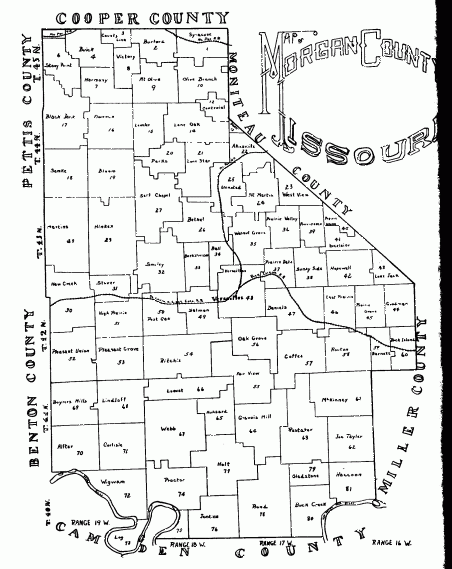
[p.11]
Another reason for selecting Morgan county is that it is a rural county. It has no large cities. Versailles, the county seat and largest city, contained, according to the 1910 census, a population of 1,598. However, as Versailles is a thriving, growing city with progressive citizens, the population is perhaps nearer 2,000 at this time.
List of Questions Submitted.
In order to get at the facts as brought out in this bulletin, a list of questions was mailed out by Superintendent Witten to all the public school teachers of the county. Some of the questions were to be answered direct by the teacher, others were to be submitted by the teacher to the pupils, and the reports from each district to be compiled by the teacher in charge.The following questions were answered direct by the teachers:
Name of school? District clerk, name and address? Number of farms in district? Number of farms reporting? Name of teacher? Address while teaching? Home address? Where educated? Where born? Age? Born in town or country? Length of present school term? Salary? How many terms have you taught? When was schoolhouse built? What kind of building? Is school yard fenced? Has any effort been made to beautify school grounds? What is the source of school water supply? Does it have to be carried, and if so, how far? Number of acres in school grounds? Is the schoolhouse in the middle of the grounds? Is the stove in the middle of the room? How many boys and girls in the district have finished country school and have never gone anywhere else? How many boys and girls in district have finished country school and have gone to high school? How many people in your district over school age? How many under school age? Number of children of school age in the district? Number of children in the district who have gone away to college or university? How many of these have come back and are now living in the district? Number of children who have attended some high school? Is there a school library? Is the schoolhouse ever used for religious services? Is schoolhouse ever used for debating societies or other gatherings? How many families have moved from district into town during the last two years? How many families have moved from district to some other place in the county during the last two years? How many town families have moved into district? How many country families have moved into district? How many country churches in the district? Of the country churches, how many have preaching every Sunday? How many twice a month? How many once a month? How many have no preaching? How many churches have Sunday school a part of the year but no regular pastor? Is there a preacher living within or near the district? How many dwelling houses have been built in the district during the year? How many country residences in the district? Are there any beef clubs or any other forms of co-operation in the district? Is there a doctor living in the district? Number of stores in district? How many sawmills in the district? What is the total output? Is there any mining carried on in the district, and if so, what kind—coal, lead, clay, etc.? About what was the total output of mineral in your district last year? Is there any farm manufacturing such as the making of baskets, brooms, ax handles, weaving of carpets, making of rugs, etc., and if so, what?
[p.12]
The following questions were submitted to the school children in each district and the answers were compiled by the teacher in charge:
What is the material of the house in which you live—frame, log, or brick, etc.? How many rooms in the house? Is there a fireplace? Has your father built a new barn during the last year? A new silo? Has your father a silo, and if so, how many? Does he own a manure spreader? What farm machinery has he—binder, mowers, wagons, etc.? Has he a windmill, and if so, how many? Is there on your home farm a spring house where milk and butter are kept? A cave or cellar? How is your home farm fenced—rail, wire, hedge etc.? Has your father an automobile? Is there a water system in your house? A telephone? How many acres of land in the farm on which you live? Do your parents own the farm or rent it? If owned, how long have they owned it? If rented, how long have you lived on it? What is the source of drinking water at your home? If a spring, how far is spring from the house? Does your father haul drinking water in the summer time? Has he an ice house? A drilled well? Any pure-bred or registered live stock on the farm? If so, what? Does your father keep bees, and if so, how many colonies? Have you a lamb, pig, sheep, pony, or other live stock of your own, and if so, what? How many hogs does your father butcher each year? Is this enough meat for the family use? Does your father ever sell any meat? Have you ever found a bee tree? Do you trap wild animals for their furs? Have you any chickens that are your own? About how many chickens are kept on the farm? How many chickens were raised during the year 1914? How many turkeys? What was the largest number of hen eggs gathered in any one day last year? How many dozen eggs were sold last year, and what was the total price received for same? How many pounds of butter were sold and what was the amount received for same? What crops were grown on your father's farm last year? How many acres of each and what was the average yield per acre? Does your father make use of commercial fertilizer? How many tons of commercial fertilizer did he buy last year and what was the cost of this fertilizer? What is the principal source of income from your father's farm—wheat, hogs, timber, cattle, hay, etc.? Has your father ever tried growing alfalfa? If so, how much has he and when was it started? Has he an orchard? If less than one acre, about how many trees are there in the orchard? If more than one acre, give acreage? Does he spray his orchard? Is there any open range for live stock near your father's farm? How far is it from your father's farm to the nearest doctor? Do you get your mail on a rural route? If not, how far is it to the postoffice? Have you started a bank account of your own? Have you saved any money from things that you have sold off the farm? What is the principal occupation of your father, or of the head of the family in case the father is dead? Any railroad ties sold during the last year, and if so, how many? Have you ever attended a picnic? Have you been to a fair? Does your family or any member of the family take a farm paper? How many papers come to your home each week? How many children of all ages, living or dead, in your family? How much money have you by your own efforts ever been able to make in one winter? How many head of cattle, sheep, horses or other live stock was sold from your father's farm during the last year? What fishing streams or lakes, if any, in your school district? Is your father's farm all prairie or all timber, or is it part timber and part prairie?
[p.13]
Illustrations.
The illustrations used in this bulletin are from pictures supplied through the office of Superintendent Witten. They show, in a general way, the diversity of Morgan county and portray in part the progress of the people. Unfortunately, photographs showing many of the most modern farm improvements and picturing the agricultural advancement made during the last year or two could not be secured in time for use in this bulletin. For this reason the illustrations do not do full justice to the county. It is also to be regretted that lack of funds prevented a larger use of illustrations, as many pictures of merit had to be left out because the cost of making the larger number could not be met.
Public Schools.
Under direction of Superintendent Witten, Morgan county has a good system of public schools. However, in only a few of the seventy-five districts are there modern school buildings. The schoolhouses are, with few exceptions, of the old square type, but there is an apparent tendency, as new buildings are needed, to have these of a more modern style of architecture, better suited to the health and comfort of the pupils. Practically all of the buildings are frame structures. However, there are six schoolhouses built wholly or in part of concrete, two modern brick buildings, and one log schoolhouse. One of the brick buildings is in Versailles, the other in Stover. A few of the schoolhouses are old and some are in poor repair. The average age of all the schoolhouses is a little more than twenty-two years. Eight schoolhouses have been built since 1910. One built in 1860 is reported as "old, weather-beaten and patched, and pierced by bullets of the Civil war."With one or two exceptions, all the rural schoolhouses are heated by stoves. In forty-five of these buildings the stove is in the middle of the room, and in only a few of these are the stoves properly placed and jacketed so as best to distribute the heat. As furnaces and less expensive and generally satisfactory heating systems are introduced in the country, their value is sure to be appreciated, and with the enterprise characteristic of the people, it is safe to predict that within a few years more satisfactory systems of heating than those now in use will be employed in districts that are able to bear the expense.
[p.14]
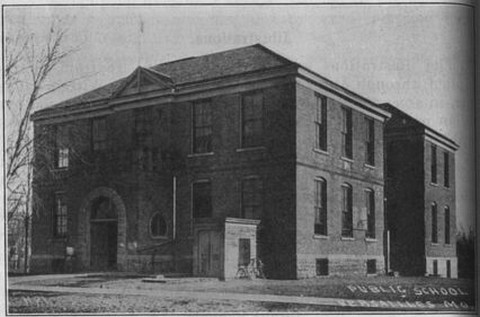
Public school building in Versailles.
The average size of the school ground is approximately one acre. In twenty-one instances the location of the schoolhouse is in the center of the grounds, rather than at one side, where it would afford more opportunities for an ample playground. In only sixteen districts are the school grounds fully fenced, but in forty-three districts some effort has been made to beautify THC grounds and to make the more-than-half-year home of the boys and girls more attractive. Surely this is worth while, for, as has been stated by Prof. O. J. Kern, "Our boys and girls absorb environment."
There is no school district without some kind of library. It is true that in many instances the start made has been small, yet where the books are properly selected and cared for the effort toward building up a district library has been found well worth while.
Morgan county seems to have made better provisions for good drinking water at the schoolhouses than has been made in a number of other counties. Forty-nine districts report a well or cistern in the schoolyard. Of these eighteen are known to be drilled wells, and it is probable that a very much larger proportion are wells of this kind. In six districts springs are depended upon as a source of water supply. Inasmuch as Morgan county has many springs of clear, cold, pure and sparkling water, especially in the southern part of the county, this source of water supply is probably as good as could be had in the districts referred to. In twenty districts no provision has been
[p.15]
made for a water supply, but the water is carried from farm houses or from springs located some distance from the schoolhouses. In several districts drinking water for the school is carried from 100 to 400 yards, and in a few, from a quarter to a half mile.
The statement frequently has been made that as a large per cent of the teachers are young men and women (and especially the latter) from towns and cities, they know little or nothing about rural conditions and are not in sympathy with farm life. This does not seem to be true of Morgan county. Of the 87 teachers who state whether they were born in the country or in town, 69 are from the country and only 18 from town. The average salary paid the teachers of the county is $45.98 per month; that of teachers born in town, $46.50. The proportion of women teachers is perhaps somewhat less in Morgan county than in other counties of the state. Information on this question shows 27 men and 61 women engaged in teaching. The salaries of the men average $52.04; those of the women, $43.16. The number of native-born teachers in the county is relatively large, fifty-five teachers stating that they are natives of Morgan county.
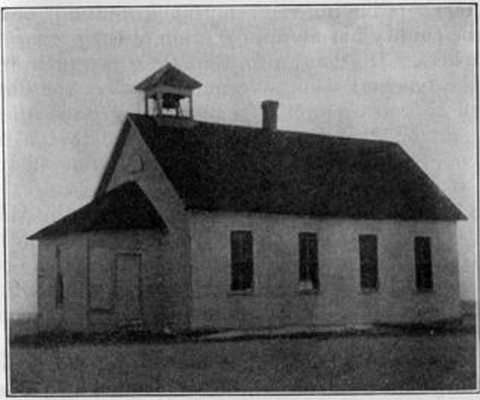
One of the rural schoolhouses in Morgan county.
The average age of the teachers in Morgan county is 24 years and 6 months. Twenty-eight teachers are under 21 years of age, while but five are over 40 and only two more than 50 years of age. The average salary of those under 21 years of age is $41.51, while the average salary of those over 40 years of age is $46. The average number of terms taught by all the teachers
[p.16]
is 5.1, while 28 teachers have either had no previous experience or have taught but one term. Of the latter, the average salary is $40.08.
Fifty-two teachers have taught two or more terms, and these receive an average of $50.36. Twenty-one teachers have taught six or more terms, and these are paid an average salary of $55.36. Ten teachers have taught ten or more terms and receive an average salary of $59.52.
The size of the district seems also to have much to do with the salary. Taking the county as a whole, there are 27.4 farms to a district. Ten districts, each having 40 or more farms, pay an average salary of $52.80. In each of five districts the farms number 12 or less, and these pay their teachers an average salary of $35.70. In 33 districts the length of the school term is eight months or more. For the county as a whole, the average school term is 7.4 months.
Practically one-half the teachers in the county have had some normal school training. While this training has in many instances been limited to one or more terms during the summer session, it speaks well for the spirit of the teachers. It is also interesting to note that while the average salary of all the teachers in the county is $45.98, the average pay received by the forty-one teachers having some normal training is $51.04. Apparently the county has an appreciation of the preparation made by the teachers. It seems, also, that there is a greater tendency to retain the teachers who have made good in the district than is the case in most counties. In other words, there is less "rotation" among teachers, the result being that a number of teachers have continued to work in the same district for period of years.
Of the pupils who have recently finished the rural school course and then failed to continue their studies elsewhere then are 294. Those who have completed the rural school course and have continued their studies in some high school number 173.
From the rural districts there have gone to colleges and universities 203 boys and girls. Of these only 106 have returned, the others seeking employment or locating elsewhere. Just how large an influence those who failed to come back to the old home might have had had they chosen to help solve local problems and assisted in local leadership is hard to estimate. In common with practically every other county, Morgan is suffering a loss because of the failure of those who are among the best equipped of its young people to come back home and assist in community upbuilding and betterment. The great need of the average rural community is local leadership, and in this the communities in Morgan county are no exception.
[p.17]

Here and there, where the first settlements were made, are old houses that seem almost to have souls. This house is said to have been built more than one hundred years ago.
Social and Religious Life of Communities.
Owing to the sparse settlement in parts of Morgan county, the number of rural churches is smaller than in some counties of the state. Nor are these churches all as prosperous as they might be. In common with practically every other county, Morgan is facing the problem of the rural church, how to keep it alive, and how to make it best serve the community as a whole. Forty-six churches, representing the various denominations, are represented, but not all of these are active congregations with regular preaching. It is true, though, that in many of the churches of the county are to be found examples of thoroughly efficient, progressive working church memberships. Northeast of Versailles, where is to be found one of the most progressive and agricultural sections, is the large Mennonite settlement, the membership of which believe in good live stock, advanced agriculture and right living.
Of the newer church buildings, especially in the towns and villages, a goodly per cent are of modern styles of architecture. Efforts have also been made to beautify and make attractive the surroundings. Wherever in the county there is an active church of any denomination, its influence is evident in the social life and often in the business life of the community. In one instance, at least, an effort has been made at church con-
[p.18]

This effective road-building machine, the Pioneer Tractor, bought at a cost of $5,000, made 100 miles of good road in Morgan county last year. Costs $25 per day to run engine and three graders. This machine well expresses the good roads spirit in Morgan county.
solidation with a view to strengthening the religious life of the community. In nineteen schoolhouses religious services are sometimes held.
Of the rural churches in the county eight report preaching every Sunday, eight twice a month, and twenty-five once a month. Five districts having churches report no preaching. In thirteen districts a Sunday school is held a part or all of the year, but there is no regular preaching. Twenty-nine districts report a preacher living in or near the district.
In forty-five districts the schoolhouses are used for debating societies, literary societies, or other neighborhood gatherings. Thus are the people brought together from time to time in a social way. Such gatherings encourage the spirit of community co-operation, result in better acquaintance and closer friendships and go far toward establishing the best of community life.
But little of a permanent nature has been done in the way of agricultural co-operation in the county. However, the farmers are in many instances working together in a small way. There are a number of beef clubs in the county. Farmers of various communities also club together in such work as filling silos, threshing and harvesting. Nor have the "barn-raisings" and the "wood-choppings," customs inherited from a pioneer period but worthy of emulation, been forgotten. There are also mutual insurance and mutual telephone organizations.
It is in road work, perhaps, that we find the finest spirit of co-operation in the county. As a result of this co-operation in an effort to secure better roads, Morgan county has built some
[p.19]
of the best roads in the state. The road south from Versailles to the Ozark regions is a splendid monument to the enterprise of the people, both in town and in country. Three years ago sixty citizens of Versailles and community formed a stock company and at a cost of $6,000 purchased a power road grader and scarifier for use on Morgan county roads. This modern road machine has been of great value in improving the county highways.
In view of the fact that much is written as to the movement from town to country and from country to town, figures touching this question in a county which has gained in rural population while many others have lost should be interesting. (In 1910 the population of Morgan county was 12,863; in 1900, 12,175.) Of the seventy-five districts in the county, fifty-six report one or more families as having moved to town within the last two years. The total number of families having so moved is 157. Sixty-one districts report one or more families as having moved to some other place in the country, such families numbering 186. Forty-eight districts report one or more families as having moved into the district during the last two years, there being a total of ninety-four such families. Sixty districts report a total of 225 country families as having moved into the districts during the last two years. From these figures it will be seen that for the last two years the movement from the country to the town has been considerably greater than the movement from the town to the country.
In only six rural school districts are there resident physicians. The average farm home is 3.8 miles from a doctor and 2 ¾ miles to the postoffice. However, as has been stated, a large per cent of the homes are on rural routes.
In practically every rural home some newspaper is taken, and in most of these homes an agricultural paper is read. The average rural family subscribes to three papers, and in each instance one or more of these are county papers.
Before passing from this subject it should be said that the people of Morgan county are peaceful and law-abiding. Many are descended from that sturdy pioneer stock that came west from Virginia, Kentucky and Tennessee. Others from northern and eastern states have brought to the county a decided spirit of progress. There are also many progressive and industrious citizens of German blood. There are in Morgan county no large cities, the influence of which is too often hurtful rather than helpful. Nor is the typical "tough community," with its bullies and its law-defying element, today to be found within the confines of the county.
[p.20]
The Farm Boys and Girls.
As no country produces a better crop than its children, it is a pleasure here to speak of the boys and girls of Morgan county, a majority of whom have had a part in the preparation of this bulletin. Fortunately for these boys and girls, they are being reared amid natural rather than artificial surroundings, and most of them are apparently being educated for the farm rather than from it. If we may judge from the papers, essays and reports submitted by the school children, there is being cultivated a love for the farm and the farm home. This is as it should be. Apparently the parents appreciate the fact that the best way to keep the boy and girl on the farm is to give them an interest in the farm. In forty-one of the school districts a good per cent of the children have started bank accounts of their own. Of those so starting bank accounts forty-three per cent personally earned the money rather than having had it given to them. The amounts earned by the school children, as reported by the survey, are rather indefinite and vary considerably. In one district thirteen pupils report having earned a total of $569 during the year. In another district the pupils earned $368.50.
Poultry is one of the principal sources of income of the children. The trapping of wild animals for their furs also nets many dollars to the farm boys, 299 of whom report that they have earned some money from the sale of furs during the year. In sixty-two districts some of the children have chickens of their own. Another but less important income in which some of the older farm boys who are yet in school share is that from bee trees. There are still many bee trees found in the wooded portions of the county. It would seem also from the survey that the farm boys and girls of Morgan county own more live stock than is owned by those in many other counties. In the reports made to the teachers it is shown that the boys and girls who are still in school own 368 pigs, 63 ponies, 97 sheep, 119 horses, 157 cows, 91 lambs, 38 calves, 10 mules, 342 hogs, 21 goats and 21 donkeys or burros. These figures and classifications are just as the school children reported them.
As the best farmer is the one who now and then goes away from home, gets new ideas and returns to put them into practice, so is the child benefited by an occasional visit. In the full development of the normal child there is need of play, recreation and pleasure. Children need to come together and develop the play instinct. Then youth wants to see. The
[p.21]
Land of Over There, even though it may be no greater distance than the adjoining township or near-by town, is a land of interest. In this connection it may be said that, according to their own reports, practically every child in Morgan county has been at a picnic, and more than eighty per cent have attended a fair, many going to the State Fair at Sedalia.
Farm Homes.
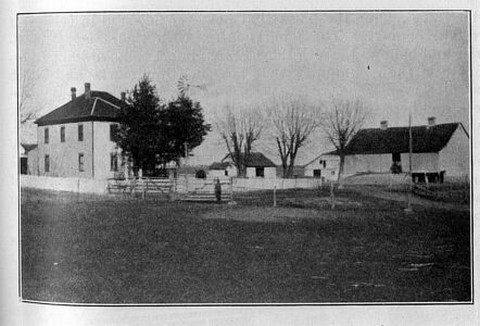
On a well-improved farm where registered live stock makes money for the owner.
As it is the farm home that most fully reflects the real life of any rural community, we naturally turn with interest to the reports covering this subject in the Morgan county survey. In a district long settled, first by the woodsman, the hunter and trapper and the primitive farmer, who in turn were followed by the more modern farmer, we find many types of rural residences. As was the custom of the early settler, the first clearings and the early farms were located near sources of water supply and within or adjacent to the timbered portions of the county. Not until later did the pioneer push his way out onto the wide prairies, which somehow he at first looked upon with doubts and misgivings. The early settler knew and understood woodlands. To him the trees were as friends, and somehow he felt lonesome on the long prairie stretches.
Here and there as one travels over Morgan county he finds old houses, roomy and picturesque, symbols of a civilization
[p.22]

A log cabin. Some homes of this type are still to be seen in the timbered district in the southern part of the county.
which was among the finest that has ever flowered in this great western country. These old houses, with their sacred memories and hallowed associations, seem almost to have souls. Fortunate is the community that has such landmarks and which has preserved them. Here, too, was the log cabin of the pioneer, and here still are some of these similarly constructed homes, humble and unassuming, yet within which dwell a rugged, virile, honest and dependable people—a people which unfortunately are passing. Always there is the need within the nation of the strength and determination of purpose which mark the lives of these men who, unafraid, go forth to fell the forest and to build homes.

A comfortable and roomy farm home.
[p.23]
Meeting the demand of modern times, and in keeping with the advancement of the county, came the more modern rural home, the larger and perhaps more pretentious farm residence. Lacking in the natural beauty and attractiveness of the surroundings that characterized the early farm home, these newer places, many of them on the prairies, yet surrounded by groves of beautiful shade trees, have gained in the architecture which makes for beauty.
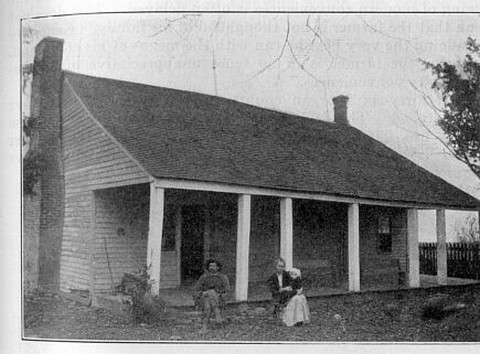
A remodeled home dating from early days. Note from Peter Binkley (17 Mar. 2001): This appears to be the same family as in image on p.40.
While such modern conveniences as light, heat and water systems for the rural home are not yet within the reach of all, these improvements have been made a part of quite a number of farm residences throughout Morgan county.
A report as to material used in the construction of the farm residences in Morgan county shows 1,658 frame buildings, 320 log, 106 frame and log, 6 cement, 6 concrete, 5 brick and one stone structure. These figures, while incomplete, give a fair idea as to the general character of the houses in the county. The average farm house consists of 4.5 rooms. In 184 of these farm homes the old-fashioned fireplace continues to give forth its warmth and cheer, and is it too much to say that perhaps these fireplaces, around which the family gathers when the day is done, have no small place in the making of that ideal home life which is so typical of this county?
[p.24]
While it is true that in some parts of Morgan county neighbors are some distance apart, yet there is, not even under these circumstances, the isolation characteristic of the far west or of the newer countries. Through the rural free delivery mail service and the rural telephone communication is easily had with the local neighborhood and the outside world. Of the rural homes, 1,278 have telephones and 941 homes are served by mail carriers on rural routes.
Where the farmer must improve and pay for his home the coming of modern conveniences is often delayed. This does not mean that the farmer is not thoughtful of his family. Generally he is doing the very best he can with the means at his command. However, the farmer is in no sense unappreciative of the so-called "city conveniences."
In thirty-six Morgan county homes water systems have been installed. The drilled well with windmill and tank is also in large use, 446 farms having this convenience. The number of drilled wells in the county is 2,409, and many farms have two or more such wells.
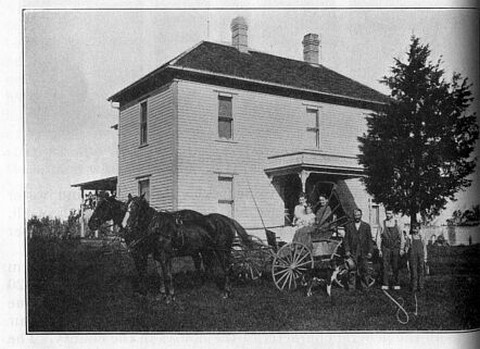
Farm home in prairie section of county.
Then there is the spring, for no county has finer spring water than is to be found in Morgan. Two hundred and sixteen farm families depend upon springs as a source of drinking water. While some of these springs are conveniently located, a large number of them are distant from the houses, so that the
[p.25]
carrying or hauling of water is a big undertaking. For springs that are not near the houses, but on some part of the farm, the distance water must be hauled or carried averages 213 yards. As a result of these springs, there are many spring houses where milk and butter are kept in the best of condition, and where, somehow, these dairy products seem to have a little finer flavor the clear, cold, sparkling water which cools them. There are 101 of these spring houses reported in the county. Fifty-three farm families have no adequate provision for an all-the-year-round supply of drinking water, but depend upon hauling it in the summer.
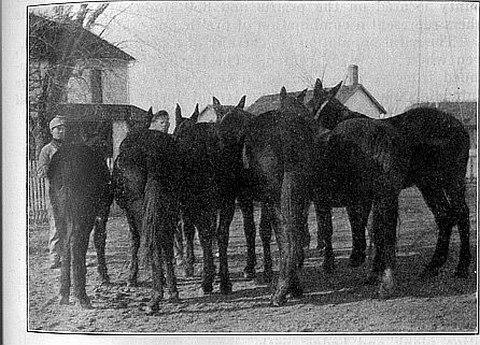
Mare and five of her colts on Morgan county farm.
That the comfort of the family is being looked to is shown by the fact that on sixty-four farms there are ice houses, and that the cellar or "cave" is common is shown by the report of 1,001 such conveniences on the farm. During the last two years 98 new farm residences have been built in the county.
Farms and Farm Equipment.
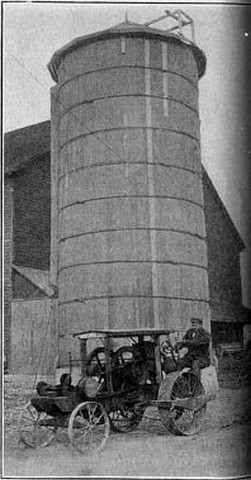
Silo, barn and farm-built tractor.
At the time this survey was made Morgan county was credited with 107 automobiles, but this number has since been increased. The survey also shows 152 silos on Morgan county farms, and of these 105 have been built during the last two years. This fact, together with the statement that Morgan
[p.26]
county farmers own 203 manure spreaders, is pretty thorough proof of the kind of farming that is being carried on. The fertility of the soil is being saved and the land built up to even a higher state of productivity. Of the number of farm operators owning their own farms the report shows 1,553, and of these farms many have been under the same ownership for twenty years or more. In fact, it is not unusual to find a third generation represented on the same farm. The average term of ownership for all farms is twelve years. There has been some immigration into the county from northern and eastern states. These new settlers have come, in the main, to the prairie parts of the county. There are 704 farms in the county located on the prairie and 350 timbered farms. The others represent a combination of prairie and woodland.
The rural population is generally of a permanent character, even where farms are rented. The leases are frequently continued from year to year for a term of years. The average rented farm has had the same tenant for three and one-half years. All this has its influence in promoting better farming. Most of the farms of Morgan county, excepting in the rougher districts or where open ranges prevail, are well fenced. Of farms reported, 953 are fenced mainly with wire, 296 with rails and 33 with hedge. Plank fences are more largely used on twenty farms. Three report a combination wire and hedge fence, and eleven, combination plank and hedge, with eleven reporting primitive brush fences common to the newer, timbered country. Where farms are fenced with plank, they are usually near a sawmill.
The equipment of the average Morgan county farm is perhaps just about in keeping with that for the entire state. The survey shows 645 binders, 995 mowers, 2,052 farm wagons, together with the usual
[p.27]
equipment of other tools and machinery. Many of the wheat drills are provided with fertilizer and grass-seeding attachment. The gasoline engine is coming into more common use, being a part of the farm equipment of a fair per cent of the farms. The gasoline tractor as in use on fewer than a dozen farms. As showing the interest in dairying, nine farms report cream separators in use.
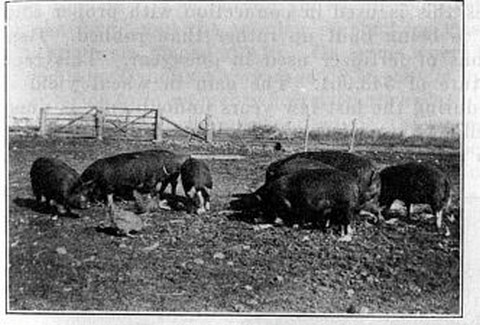
The "razorback" has been replaced by such hogs as these.
Live Stock and Poultry.
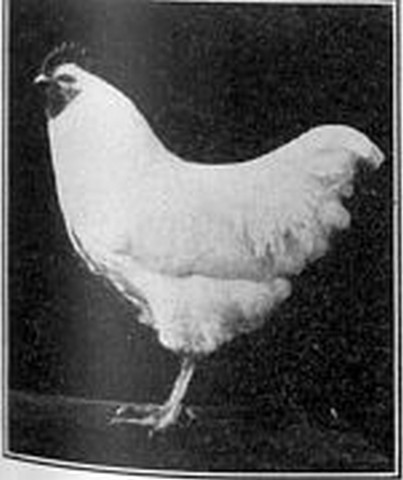
Morgan county has much good poultry.
During the last few years the live stock of Morgan county has been greatly improved, although the proportion of pure-bred animals is still somewhat smaller than for some other counties in the state. The scrub steer and razorback hog, once common in this county, have given place to better and more profitable animals. On practically every farm there is good live stock, but in most instances these are grades rather than pure-bred animals. On a number of farms, though, registered herds and flocks are being built up.
Live stock of some kind is owned on practically every farm. The survey as made by the school pupils of the county shows live stock sales for the year as follows: Horses, 1,529 head; cattle, 8,337 head; sheep, 5,218 head; hogs, 22,747 head; mules, 617 head; goats, 281 head.
[p.28]
The poultry industry is receiving special attention, and on many farms there are fine birds. As is common throughout most of the state, the poultry industry finds its chief impetus in the interest that the farm wife or daughter gives to it.
Use of Commercial Fertilizers.
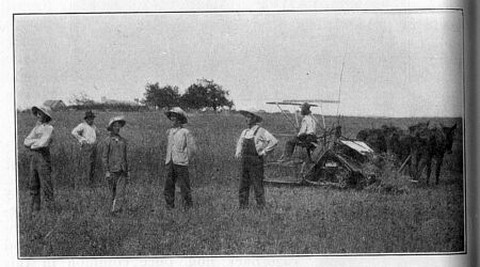
Morgan county is increasing her wheat yield.
Commercial fertilizers, especially for wheat, are coming to be quite extensively used on Morgan county farms. In most instances this is used in connection with proper rotations and the soil is being built up rather than robbed. Reports show 1,667 tons of fertilizer used in one year. This represents an expenditure of $43,961. The gain in wheat yield in Morgan county during the last few years undoubtedly is due in part to the intelligent use of commercial fertilizers, together with crop rotation and more care as to the seed and seed bed.
Sources of Farm Income.
The sources of income for the average Morgan county farm include both grain and live stock. Wheat represents about the only grain crop sold direct. Corn, oats and hay crops are fed on the farms.
From the timbered sections in the southern part of the county there are sold each year thousands of railroad ties, also large quantities of hardwood lumber.
Alfalfa has been tried out, generally in a small way, in forty-six school districts of the county. The entire alfalfa acreage is placed at 593 acres. Practically all of this has been seeded during the last four years.
[p.29]
Parts of the county are well adapted to the growing of fruits. Reports show 1,045 farms having small family orchards. There are no large commercial orchards in the county, and only one or two containing five or more acres. Spraying has not come into general use. In thirty-one districts of the county there was still some open range for live stock, but practically all of this is in the southern section.
The poultry industry is one of the large sources of income for the county. The, survey shows an average of 109 chickens on the farm, and the number of chickens raised, per farm, during the year is placed at 119. On farms where turkeys were raised the report shows an average of 28, but is indefinite as to the number of farm women who raised turkeys.
Taking the farms of the county as a whole, the largest number of eggs gathered during any one day averaged 71 per farm. Eggs sold during the year brought $77,088, an average of about $1,000 to the school district, according to the reports of the pupils. Sales of butter and cream (and in more than ninety per cent of these reports butter rather than cream is considered) averaged $152.27 per district for the year.
Most of the honey is consumed on the farms where produced, yet a small per cent finds its way to the local markets.
The number of hogs butchered on Morgan county farms averages 4½ per family. Of the farmers reporting, 898 provide enough meat for their own use, but 286 depend upon buying some meat. There are no reports on this question from other farm homes in the county. Less than ten per cent of the farmers have a surplus of bacon to sell. Where pork products of
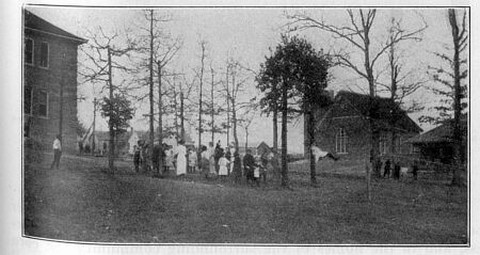
Modern school building, church and playground in thriving little town of Stover.
[p.30]
any kind are sold, bacon and "side meat" and fresh sausage make up the bulk. Beef clubs supply fresh meat to many farm homes during the summer season.
Towns and Villages.
While this is purely a rural survey of Morgan county, the fact remains that in the discussion of all such questions corporation lines must be lost, as the interests of city and country are one and the same. While Morgan is distinctly a rural county, it has in Versailles, the county seat, a thriving trade center. Versailles has two railroads, is blessed with enterprising, up-to-date citizens, and its business enterprises are entirely in keeping with those of the county. Throughout the county are a number of smaller towns and villages and country stores, which are the center of the community life. In the larger villages there are good business houses and beautiful and attractive homes. In the southern part of the county especially, the country store and hamlet, with but few houses, survives and still fills a large place in the lives of the people.
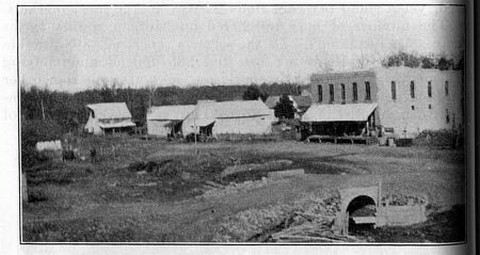
A hamlet in the southern part of the county. Notice new concrete culvert on Versailles and Linn Creek road.
Old Mills.
Morgan county has a few mills that are still driven by water power. In some of these mills corn is ground after the old process, and in the homes of the surrounding community the corn bread of the pioneer, together with the southern "johnnycake," and even "cracklin' bread," is not unknown. One by one, how-
[p.31]
ever, these old mills, with their picturesque races and beautiful lakes or streams near by, are being replaced by those supplied with modern power.
Mining and Manufacturing.
Coal, lead, jack, tiff and clay are mined in Morgan county, but the mining interests are not as yet fully developed. There are, however, immense deposits of coal. A fine quality of clay is found, and near Versailles is located a large clay plant. Among the articles of manufacture in a commercial way are brooms, and, as a result, some broom corn is grown in the county. Ax handles are also manufactured. Then the home arts, such as the weaving of carpets and rugs, and in some instances the carding and spinning of wool, are still carried on. Baskets and other wood products come from many of the farm homes, especially in the timbered sections of the county. Years ago a woolen mill giving employment to twenty or more people was operated south of Versailles, but after having been continued with more or less success for quite a long period of time, the work was abandoned. The old mill still stands, and is today used as a barn or stable. In the timbered sections of the county, sawmills are still operated. Reports show thirty-eight such mills.
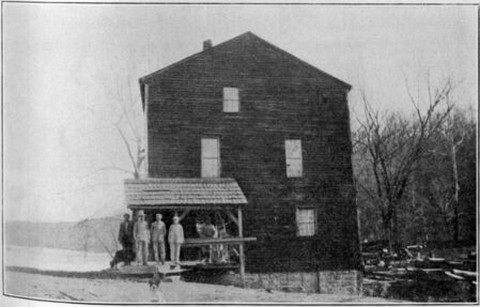
Old grist mill on the banks of the Gravois. Mill is driven by water power, the water being conveyed about two miles, through a race, into a lake. Mill was built before the Civil war. Patrons come for many miles to this mill, where corn is ground by use of old-fashioned burstones.
[p.32]
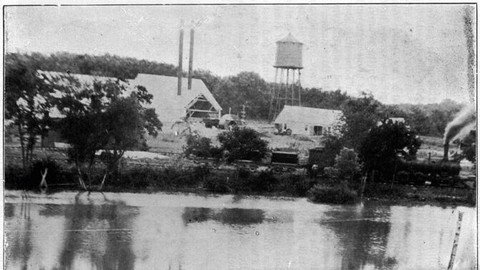
Partial view of the big clay products works at Versailles.
[p.33]

Collins' Lake in southern Morgan county. Fed by spring which flows 45 cubic feet per second.
A Land of Great Natural Beauty.
To speak of Morgan county and yet fail to mention the wonderful attractiveness and rare beauty of much of the county, especially that south from Versailles to the Morgan county line, marked in part by the Osage river, would be a serious omission. Few counties have a greater wealth of natural scenery. There are clear, swiftly-flowing streams, with rapids and waterfalls and numerous caves and caverns, some of which have been explored to a considerable distance.
To the hunter and fisherman, or to the lover of nature, whoever he may be, this great playground, in many parts unspoiled by the hand of man and almost unchanged by the march of civilization, appeals most strongly.
Morgan County Crop Yields.
Reports of yields of some of the principal crops for the year 1914, made by the pupils in the public schools, are interesting as sources of comparison with the official crop figures for the same year. The student report shows an average yield of 20 bushels of corn, 20½ bushels of wheat, 25½ bushels of oats, 1.7 tons of hay per acre for the year 1914. The official figures
[p.34]
for the same year are as follows: Corn, 22 bushels; wheat, 19 bushels; oats, 18 bushels; hay, 1.5 tons. The comparatively small differences are due, we believe, in part to the fact that the school survey on this question includes reports from only about two-thirds of the farms in the county. There is reason for believing that the estimates as made by the students, and in practically every case assisted by their parents, are unusually accurate and are valuable as sources of information.
Acreage and yields of the principal crops grown in Morgan county during the year 1914 are reported as follows by the State Board of Agriculture:
Wheat, 21,310 acres; average yield per acre, 14 bushels; total yield per county, 292,373 bushels.
Oats, 6,510 acres; average yield per acre, 25 bushels; total yield per county, 162,750 bushels.
Corn, 42,038 acres; average yield per acre, 34 bushels; total yield per county, 1,303,178 bushels.
Tame hay, 20,014 acres; total yield per county, 26,018 tons.
Acreage and yields for the ten-year period, 1905 to 1914, inclusive, are reported as follows:
Corn, 39,842 acres; average yield per acre, 27.7 bushels; yield per county, 1,090,599 bushels.
Wheat, 14,421 acres; average yield per acre, 14 bushels; yield per county, 208,457 bushels.
Oats, 4,720 acres; average yield per acre, 22 bushels; yield per county, 102,864 bushels.
Tame hay and forage, 19,837 acres; county yield, 21,046 tons.
Supplementary Reports.
Many teachers, in addition to replying fully to the questions asked, submitted excellent supplementary reports. The following is typical:
One mile north of Barnett is the south line of district forty-five. The district is two and three-fourths miles from north to south, and two and one-half miles east and west. It is a farming section, there being in the district thirty farms, with an average of one hundred acres per farm.
Practically all the farms are prairie land and are fenced with wire and hedge fences. On these farms we find comfortable farmhouses and good barns.
The principal crops grown are wheat and corn. Commercial fertilizers are used in the raising of these crops, especially wheat, and the increased yield amply repays the farmers for the expense of the fertilizers.
Most every farmer raises some kind of live stock, such as horses, sheep, cattle and hogs, and the farmers' wives excel in the raising of pure-bred poultry.
There are no churches in the district, but there are several churches only a short distance away, and these the people attend and in their quiet way do all in their power to advance the cause of Christ.
[p.35]
The school, Prairie Grove, is in the central part of the district. Literary meetings are held in the schoolhouse this winter, thus making the school the social center of the community.
There are no towns or villages nearer than three and one-half miles, but there is a rural mail route through the district which enables the people to get their mail each day.
The people are friendly and hospitable and are of a progressive nature. They are not to be won over by every fad and fancy, but when some movement is started which they think really worth while they are ready and willing to co-operate with the leaders and make that movement a success. They are strong morally and mentally; they fight life's battles bravely and fearlessly, and they make citizens who bear their part of the nation's burden patiently and loyally.
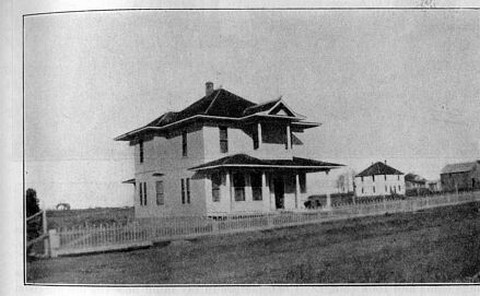
A modern home in Morgan county.
Farm Homes as Described by School Children.
In addition to filling out the list of questions, many pupils in the public schools supplied papers in which they described the farm home. Were it possible to do so, many of these essays would be reproduced in this bulletin. The following, however, some idea as to the high character of this work. A pupil of the Glensted school wrote as follows, taking as her subject, "My Country Home."
I live on a farm of 200 acres, three-quarters of a mile northeast of Glensted. Our farm has four forty-acre tracts running north and south. On the second forty from the north running to the east is another "forty." Two forties to the north the forty running east are north of a county road. Just across the road on the third forty from the north is our home. The other forty running on to a county road on that side.
In the north forty, running south to a branch, is a twenty-acre meadow. Across the branch in the remainder of that piece are two acres of alfalfa, eleven
[p.36]
acres of pasture and seven acres of meadow. Running along the west of the second forty are fourteen acres of wheat. On east of the wheat is a ten-acre pasture.
East of the pasture is an old-fashioned house that any one would be proud of and which was formerly occupied by my grandmother. Although my grandmother has been dead for over two years, her old house still contains things of which my father and his family are proud.
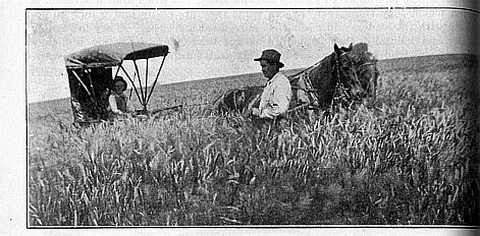
In one of the many good wheat fields in Morgan county.
The house is old, one room having been built long before the Civil war. On the front door, facing this large room, may still be seen a piece which was tacked on during the war, after some soldiers had broken into the house one day, when all the family were away.
I used to enjoy hearing grandmother tell stories about the war and how the soldiers came and took things. I can picture in my mind how the old log room looked. It now has five rooms, is weatherboarded, painted white, and has lightning rods.
But let us see what we can now see in the quaint old house. We will first go into the old log room, built before the war, and we will see on the west a large old fireplace with the two iron "dogs" (as grandmother called them) still sitting on the wide hearth, never having been used since grandmother's departure. On either side may be seen spinning wheels, which she had used for years and had spun many yards of wool for home use. They are strongly made of oak, and were possibly made by Great-grandfather Sims. While in the corner may be seen an old-fashioned loom made by Great-grandfather Sims and presented to my grandfather and grandmother. On this grandmother has woven hundreds of yards for clothes, blankets and carpets. Leaning against the side of the fireplace may be seen the old reel and "swifts" from which grandmother has "spooled" many hanks of thread.
Midway of the north side of the room is a door fastened with an old-fashioned lock. In the southeast corner of the room is the rope-corded bed with its posts rising like ghosts.
On around the south wall is the door in which we are standing. Turning our face to the west, we see the stairway running almost straight up. By this door is a picture of my grandfather and his family, and under the picture sets the old lounge over which is spread a homemade woolen coverlid, woven by my grandmother upon the loom pictured. Five generations are represented in this picture.
[p.37]
The loom, and chair in which father is sitting were made and owned by Greatgrandfather Sims, while the room of which we are speaking was owned by grandfather, and my father is sitting by my sister's lounge, holding her son. I think this room with its homemade furnishings make a complete picture.
If we should go on through the house we would see many other interesting things, but we will drift on to the outside of this old home.
The house is situated in the center of a big yard, shaded by large cedars, cottonwoods, locusts and walnuts. The smokehouse, with the cellar under it, still stands. The henhouse and barn are also still standing. Out east and northeast of the house is the garden, and the orchard, which is almost destitute of its trees.
The forty acres east of this old house is all a large pasture in which my father is feeding twenty head of cattle and nineteen head of hogs. He feeds them only once a day at the present, but will later on probably feed them twice a day. He feeds the cattle fodder and cold-pressed cottonseed "cake," and the hogs are fed corn.
Our house is twenty yards south of the road. It was built in 1908 and is a large eight-room house. It is built so that it forms the letter "T." Our barn, 46 by 59 feet, was also built in 1908.
My father raises and sells stock. He has three registered saddle horses. Their names have been entered on the registered list in Kentucky, the names being "Maude E," "Rexie Sims" and "Elberta."
I have now told the most important things of my home, and in conclusion I will say that I enjoy and appreciate such a place.
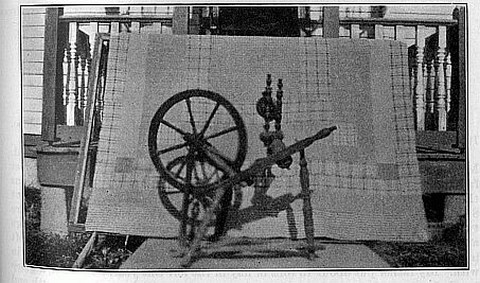
A crude machine, but notice the beautiful work when directed by skilled hands.
Following is another description of a farm home in Morgan county, this paper being one of many written by public school pupils:
Woodland Glen, a small farm consisting of 120 acres, is two miles west of Glenstead and eight miles northwest of Versailles.
My father bought this farm in the spring of 1901. When we moved to it there were very few improvements. The house consisted of one large room
[p.38]
and a shed room. Other buildings were a log crib, a log smokehouse, a log henhouse and a log barn. The barn had enough room for four to six horses. It had a loft in which could be put a little hay.
A cistern was the only well when we moved. In 1904 my father had a well drilled and a pump put in. In 1912 papa had a windmill put up and with it a tank that held eight barrels. In 1906 a new house was erected which three rooms, two rooms in front and one room in the rear. This house faces the east. It has two porches, one on the east and one on the south. In 1915 my father had a buggy and wagon shed built, and on the west is a tin-roof shed, which he uses for shelter in feeding cattle and hogs, and for many other purposes. A henhouse was built in 1909. This henhouse is about 12 by 14 feet. It has three rows of nests for the hens to lay in.
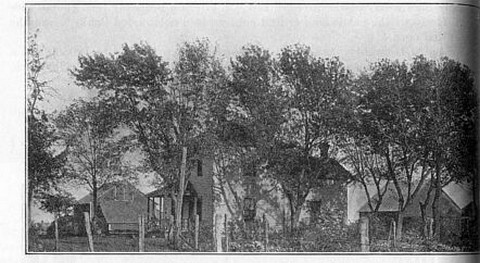
A farmstead where shade trees are a factor.
In 1905 my father bought a farmer's telephone and put it in our house. It is very useful. I don't see how we could do without it.
In 1910 the old log crib and barn were torn down and a large barn erected. My father had a concrete foundation built for it. The barn is about sixteen feet from the foundation to the roof. It has a hallway about five feet wide which runs through the center of the barn. On the west side of this hall is a granary about 8 by 10 feet, a crib which holds about 1,000 bushels of ear corn. Then there are at two double stalls for horses. On the east side of the hall are two rolling doors and three stalls, each large enough for two horses. The barn has a nice large loft in which an abundance of hay can be stored. It has a hayfork to put the hay in with. My father put about 15 tons of hay in the loft this year. We have a place for Kafir corn and our apples are in a pen covered up with hay. In the south end of the barn there is a large door which you let down in order to put the hay in with the hayfork. Last year my father had his wheat stacked so that the separator would put the straw right in the barn.
In 1911 my father fenced one forty of his land with American hog wire. He is feeding twenty-two head of cattle and twenty-five head of hogs in this pasture. He feeds his cattle corn and cottonseed cake and fodder.
We have three mules on the farm. Two of them are work mules. They are large and strong. One of them is a gray and the other one is a black. They are almost the same size and work very well together. We have two milch cows. One is a Jersey and one is a "brindle." We have four calves, and I think a great
[p.39]
deal of one of them. Its mother died when it was about two weeks old and we had to raise it as a pet. I used to be able to go up to her any place and rub and play with her, but she has gotten so that I can't play with her any more.
This year my father had fifteen acres of wheat that made about thirty bushels per acre, and ten acres that made about fifteen bushels per acre. He had ten acres of millet and fifteen acres of corn. The remainder of the farm was in pasture, except the garden, orchard and truck patch. In our truck patch we put out tomato and sweet potato plants. We plant Irish potatoes, corn, watermelons and muskmelons and different things. We had a nice watermelon patch this year. Although about half of them were taken, we had enough left for our own use. We raised a bushel and a half of pop corn.
We have about seventy trees in our orchard, some peach trees, some apple, and cherry, and one quince tree. We have one peach tree which has ripe peaches on it by the Fourth of July, and the rest of them have ripe peaches in September. We have two blackberry patches. One is in the garden, the other one is north of the orchard. We have a row of grapes which extends from one side of the garden to the other. They are tame grapes and are very nice when we have a season. Sometimes we can a few grapes while they are green.
We made sweet pickle and canned about twenty-five gallons of peaches from our orchard this year. Besides, we sold a few to our neighbors.
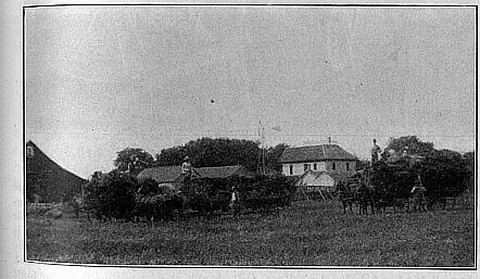
A busy day on one of the modern farms of Morgan county.
Following is still another description of a Morgan county farm home:
Glen Dale is a small farm consisting of 145 acres, situated on the banks of a beautiful stream of water.
This stream is a tributary of Richland creek. This creek is constantly overflowing, which causes some damage by washing and is dangerous to be crossed for several days.
In 1906 there was a large overflow of this stream. Heavy rains fell for several days, causing the creek to keep rising higher and higher until it looked almost a mile wide. It was a wonderful sight to watch the logs, trees, corn shocks, wire fences, posts and all kinds of things washing down this "river," as it seemed then. This overflow caused many dollars of damage to the farmers by flooding
[p.40]
the fields, destroying the corn and fences and washing away the soil. Also, some stock was drowned by being in the fields with no way to get out. Finally, after several days of such high water, the stream went down to its natural size.
There was a bridge across this creek, but when the high water came the bridge was washed away and there has never been any other built, for the overflows are so frequent and unexpected that the people cannot afford to build bridges so often.
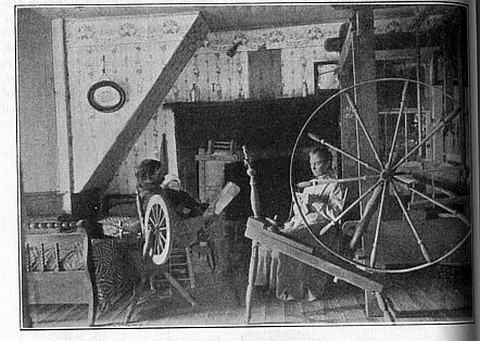
A reminder of pioneer days in Morgan county. Note from Peter Binkley (17 Mar. 2001): This appears to be the same family as in image on p.23.
Some people who own land near this creek are building a dam to change the course of the creek. The dam was begun last summer and the creek is changing real fast. These people are wanting the creek to flow through one of their other fields, which is not so valuable, and build up another field. The dam is being built of logs, trees, drifts, rocks, etc., and large posts are driven into the bed of the creek to hold the logs in position. When heavy rains fall the creek washes all kinds of drifts, logs, etc., against this dam, causing it to be built stronger.
In the summer time the creek is noted for its fine bathing, fishing and boating, and in winter for skating.
On one side of the creek are great bluffs, some of rock and some entirely covered with cedar. In summer the bluffs are covered with beautiful flowers, shade trees and moss. In winter, when the cedars are covered with snow and the caverns are hung with large icicles reaching from top to bottom, the bluffs are beautiful.
Our house is situated about 200 yards from this bluff. It was built in 1890. We have a large new barn, built in 1912. Besides this new barn, we have sheds for the cattle, a granary and corncrib.
We have a fine drilled well, which was drilled about twelve years ago. It is just 48 feet deep and affords a great deal of water, so that it cannot be pumped dry with the engine.
[p.41]
My parents have lived on this farm for twenty-eight years. When they first moved here there were just old log buildings, formerly occupied by my grandmother. Father bought the land and in a few years began building.
Mamma and we girls raise poultry and all kinds of garden products. Papa and brother raise live stock and farm products. This year they raised corn, wheat, oats, Kafir corn, clover hay and cane hay. The live stock they have now consists of five head of cattle, fifteen head of hogs and nine head of horses.
Brother has a beautiful pet pony, four years old. Her color is a deep yellow, and her name is Julia. We raised her as a pet and ever since she was a colt we would feed her sugar out of our hands.
Brother has one pony, two mules, one cow and calf and some hogs. Papa has a pretty black pony, three years old. We did not pet her so much as we did Julia, but she is very gentle. Her name is Nellie. Julia and Nellie make a pretty driving team, and are safe for ladies to drive.
Mamma has a real old spinning wheel that was my grandmother's. I can remember how I used to like to watch grandmother spin. I would always want to turn the wheel.
We also have an old loom, which was made before the Civil war. Grandfather started to make it but died before it was completed, but someone else finished it. Grandmother has woven many yards of cloth, carpet, blanket, etc., on this old wooden loom.
We have, as a keepsake, an old silver sugar shell and butter knife of my grandmother's. Grandfather died before the Civil war, leaving grandmother a widow with five children to care for during this hard struggle. During the war she buried the spoon and knife with her money to keep them from being stolen.
Assessed Valuation of Morgan County, 1915.
Osage Township.—Horses, 416, valued at $10,730; asses and jennets, 2, valued at $110; mules, 302, valued at $9,500; cattle, 1,814, valued at $23,850; sheep, 829, valued at $850; hogs, 1,604, valued at $3,225; other stock, 170, valued at $170; moneys, notes, etc., $20,160; other personal property, $5,775; total valuation, $74,370.
Buffalo Township— Horses, 440, valued at $9,805; asses and jennets, 3, valued at $280; mules, 309, valued at $9,350; cattle, 1,556, valued at $22,575; sheep, 160, valued at $160; hogs, 1,406, valued at $2,935; other stock, 50, valued at $50; moneys, notes, etc., $17,240; other personal property, $5,025; total valuation, $67,420.
Moreau Township—Horses, 1,785, valued at $50,525; asses and jennets, 16, valued at $1,060; mules, 1,008, valued at $31,970; cattle, 4,121, valued at $60,660; sheep, 676, valued at $685; hogs, 3,605, valued at $7,755; other stock, 39, valued at $40; moneys, notes, etc., $218,055; other personal property, $61,805; total valuation, $432,555.
Haw Creek Township—Horses, 1,352, valued at $39,320; asses and jennets, 11, valued at $920; mules, 783, valued at $23,605; cattle, 2,516, valued at $30,515; sheep, 719, valued at $725; hogs, 2,281, valued at $4,590; other stock, 1,389, valued
[p.42]
at $1,340; moneys, notes, etc., $140,600; other personal property, $49,810; total valuation, $291,425.
Mill Creek Township—Horses, 771, valued at $20,635; asses and jennets, 21, valued at $1,230; mules, 487, valued at $15,545; cattle, 1,166, valued at $14,850; sheep, 450, valued at $450; hogs, 1,261, valued at $2,635; other stock, 320, valued at $325; moneys, notes, etc., $80,245; other personal property, $15,475; total valuation, $151,390.
Richland Township—Horses, 837, valued at $21,080; asses and jennets, 8, valued at $375; mules, 548, valued at $18,355; cattle, 1,437, valued at $19,930; sheep, 800, valued at $810; hogs, 1,792, valued at $3,740; other stock, 565, valued at $565; moneys, notes, etc., $69,980; other personal property, $15,115; total valuation, $150,600.
Recapitulation—Total number of horses, 5,601, valued at $152,095; total number asses and jennets, 61, valued at $3,975; total number mules, 3,437, valued at $108,325; total number cattle, 12,610, valued at $172,380; total number sheep, 3,630, valued at $3,680; total number hogs, 11,949, valued at $24,880; total number other stock, 2,483, valued at $2,490; total amount moneys, notes, etc., $546,280; total other personal property, $153,655; total valuation, $1,167,760.
Valuation of farm lands, $2,377,525; valuation of town lots, $285,450; total valuation of farm lands and town lots, $2,652,975; valuation of personal property, $1,167,760; total valuation of farm lands, town lots and personal property, $3,810,735 for the year 1915.
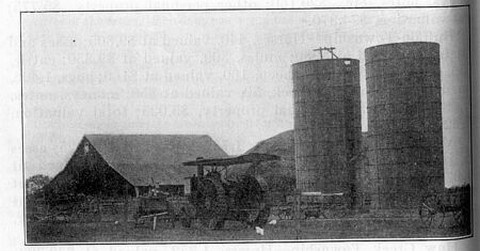
As seen on a well-equipped Morgan county farm.
[p.43]
From the 1910 Census.
The following concerning Morgan county is from the 1910 census:
Population—1910, 12,863; in 1900, 12,175. Number of all farms, 1910, 2,027; number of all farms, 1900, 2,013. Color and nativity of farmers: Native white, 1,897; foreign-born white, 116; negro and other nonwhite, 14.
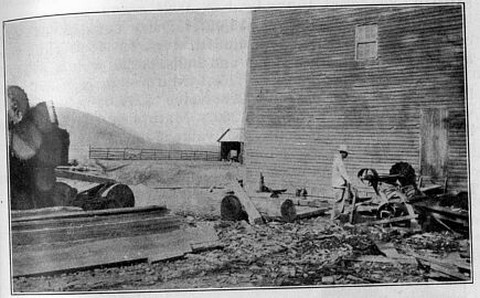
Sawmill from which comes all the oak lumber used in the district.
Number of Farms, Classified by Size—3 to 9 acres, 40; 10 to 19 acres, 60; 20 to 49 acres, 240; 50 to 99 acres, 525; 100 to 174 acres, 636; 175 to 259 acres, 320; 260 to 499 acres, 172; 500 to 999 acres, 32; 1,000 acres and over, 2.
Land and Farm Area—Approximate land area, 392,960 acres. Land in farms, 1910, 279,822 acres; in 1900, 267,457 acres. Improved land in farms, 1910, 153,263 acres; in 1900, 139,649 acres. Woodland in farms, 113,673 acres. Other unimproved land in farms, 12,886 acres. Per cent of land area in farms, 71.2. Per cent of farm land improved, 54.8. Average acres per farm, 138.0. Average improved acres per farm, 75.6.
Value of Farm Property—All farm property, 1910, $10,948,965. All farm property in 1900, $5,264,420. Per cent increase, 1900-1910, 108.0. Land value, 1910, $7,123,053. Land, 1900, $3,104,410. Buildings, 1910, $1,580,422. Buildings in 1900, $951,010. Implements and machinery, 1910, $344,944. Implements and machinery in 1900, $180,020. Domestic ani-
[p.44]
mals, poultry and bees, 1910, $1,900,546. Domestic animals, poultry and bees in 1900, $1,028,980.
Per Cent of Value of all Property in—Land, 65.1; buildings, 14.4; implements and machinery, 3.2; domestic animals, poultry and bees, 17.4.
Average Values—All property per farm, $5,402; land and buildings per farm, $4,294; land per acre, 1910, $25.46; land per acre, 1900, $11.61.
Domestic Animals (farms and ranges)—Farms reporting domestic animals, 1,986. Value of domestic animals, $1,810,319.
Cattle—Total number, 15,951. Dairy cows, 5,664; other cows, 1,597; yearling heifers, 1,861; calves, 1,931; yearling steers and bulls, 1,670; other steers and bulls, 3,228; value, $433,558.
Horses—Total number, 7,268. Mature horses, 6,370; yearling colts, 670; spring colts, 228; value, $717,039.
Mules—Total number, 3,269. Mature mules, 2,399; yearling colts, 651; spring colts, 219; value, $396,816.
Asses and burros—Number, 94; value, $27,665.
Swine—Total number, 23,053. Mature hogs, 15,262; spring pigs, 7,791; value, $173,169.
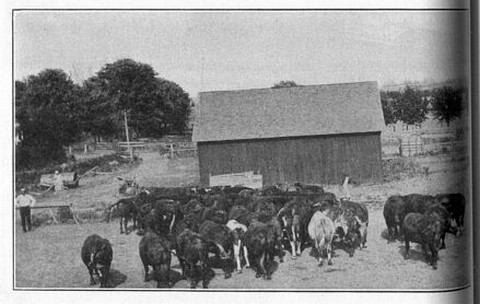
Cattle fattened on the farm help to make "fat" the farm.
Sheep—Total number, 14,063. Rams, ewes and wethers, 8,307; spring lambs, 5,756; value, $58,114.
Goats—Number, 1,239; value, $3,958.
Poultry and Bees—Number of poultry of all kinds, 154,653; value, $88,724. Number colonies of bees, 582; value, $1,503.
[p.45]
Farms Operated by Owners—Number of farms, 1910, 1,474; number of farms, 1900, 1,493; per cent of all farms, 1910, 72.7; per cent of farms, 1900, 74.2. Land in farms, 208,912 acres; improved land in farms, 120,711 acres. Value of land and buildings, $6,901,655. Degree of ownership: Farms consisting of owned land only, 1,222; farms consisting of owned and hired land, 252. Color and nativity of owners: Native white, 1,354; foreign-born white, 108; negro and other nonwhite, 12.
Farms Operated by Tenants—Number of farms, 1910, 546; number of farms in 1900, 511; per cent of all farms, 1910, 26.9; all farms, 1900, 25.4. Land in farms, 69,147 acres; improved land in farms, 31,551 acres. Value of land and buildings, $1,726,320. Form of tenancy: Share tenants, 330; share-cash tenants, 39; cash tenants, 161; tenure not specified, 16. Color and nativity of tenants: Native white, 536; foreign-born white, 8; negro and other nonwhite, 2.
Farms Operated by Managers—Number of farms, 1910, 7; number of farms, 1900, 9. Land in farms, 1,763 acres; improved land in farms, 1,001 acres. Value of land and buildings, $75,500.
Mortgage Debt Reports—For all farms operated by owners: Number free from mortgage debt, 934; number with mortgage debt, 537; number with no mortgage report, 3. For farms consisting of owned land only: Number reporting debt and amount, 387; value of their land and buildings, $1,603,610; amount of mortgage debt, $477,199; per cent of value of land and buildings, 29.8.
Live-Stock Products.
Dairy Products—Dairy cows on farms reporting dairy products, 5,094; dairy cows on farms reporting milk produced, 4,954; milk produced, 1,123,003 gallons; milk sold, 9,599 gallons; cream sold, 1,784 gallons; butter produced, 284,844 pounds; sold, 83,078 pounds; cheese produced, 100 pounds; sold, 100 pounds. Value of dairy products, excluding home use of milk and cream, $61,667; receipts from sale of dairy products, $20,653.
Poultry Products—Poultry raised, 173,107; sold, 75,478; eggs produced, 763,819 dozen; sold, 564,208 dozen. Value of poultry and eggs produced, $207,322; receipts from sale of poultry and eggs, $136,399.
Honey and Wax—Honey produced, 1,293 pounds; wax produced, 52 pounds. Value of honey and wax produced, $212.
Wool, Mohair and Goat Hair—Wool, fleeces shorn, 6,733; mohair and goat hair, fleeces shorn, 222; value of wool and mohair produced, $10,166.
[p.46]
Domestic Animals Sold or Slaughtered—Calves sold or slaughtered, 1,932; other cattle sold or slaughtered, 8,276 horses, mules and asses and burros sold, 1,873; swine sold or slaughtered, 28,841; sheep and goats sold or slaughtered, 6,693. Receipts from sale of animals, $954,846; value of animals slaughtered, $109,882.
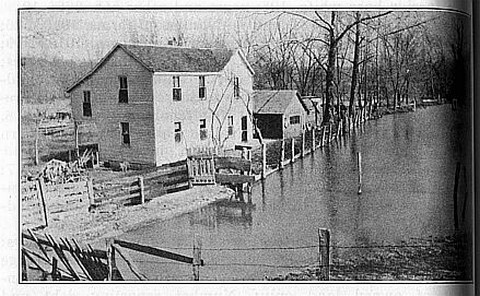
One of the farm residences in the Gravois Mills district, and lake that supplies water for the grist mill.
Topography, Streams and Soil.
The following is from "A History of Morgan County," edited by A. G. Baker, Versailles, Mo., and published in 1907:
"The county contains a superficial area of nearly 640 square miles, and its most elevated portion is 400 to 500 feet above the Osage river and from 600 to 700 above high-water mark at St. Louis. This elevation passes nearly east and west through the county, and but a little south of the middle, forming the divide of the north and south watersheds, the north streams flowing ultimately into the Missouri river and those south into the Osage river. The divide passes through Versailles, the water from the south side of the public square going south; that from the north side flowing in the opposite direction. The streams on the north are more sluggish than those on the south, and they also differ in this: The former are from pools and surface water only, while those on the south are fed by deep and strong springs, and are cold and clear, except for a short time after heavy rains. On the north the majority of the streams at
[p.47]
times become very low and sometimes dry, while at the south they are little affected by the weather.
"The surface of the county is rolling, and it is divided between timber and prairie land. The latter is rich and rolling, presenting the most beautiful landscapes to the eye when passing over the county. The prairie land is in the middle, north and northeast of the county, and is about one-third of the area. In the southern portion it is heavily timbered. The surface in the middle portion of the county is elevated, undulating prairie mostly, and towards the south there are at first slopes, gradually becoming more hilly, and when near the Osage and tributary streams, it is of a somewhat broken and rocky nature. The most elevated point in the county is about five miles west of Versailles.
"The largest stream touching the county is the Osage river on the south. It forms the boundary line of southwest and southeast corners of the county. In the south watershed is Big Gravois creek, the largest stream south of the divide. It rises in township 42, range 18, flowing southeast to the Osage, and has a length of twenty miles, with a fall of 400 feet. Is a strong stream, about seventy yards wide at the mouth, and is a fine water power. There are several small branches flowing into it, all clear and rapid, strong streams. In the southwest part of the county are Proctor, Mills, Little Buffalo and Minow creeks, and Jenkin's, Huff's and Lick branches. Such is their fall as to give them horse power for mechanical purposes. Big Buffalo creek heads in township 42, range 19, running southwest, crossing the line into Benton county. A branch of Little Gravois creek heads in township 41, range 16, running south and west for four miles, when it joins the main stream.
"North of the divide are Big and Little Richland, Haw and Flat creeks. Except Flat creek, these head in township 42, range 18 and 19, flowing northerly, and empty into Flat creek in township 45, range 19, and form the Lamine. These streams are more sluggish than the streams running south, as they have less fall. Flat creek is the largest stream north of the divide; it connects with Richland near the north county line to form the Lamine. Northeast of Versailles a short distance some head branches of North Moreau rise, flowing northeast into Moniteau county. In addition to Moreau creek are Linder's, Burris and Smith's forks. Taking Versailles as the central point, the drainage from her carries the water in all directions, but mostly north, northeast and south.
"Nearly the entire area of the county is occupied by the series of magnesium limestone and sandstone, representing the calciferous rocks—the lower part of the Lower Silurian. The
[p.48]
alluvium of the Quaternary period ranges up to forty feet in depth, in which there is slightly mixed coarse sand. The heavy alluvial deposits are in the valleys, mostly a yellowish clay, the alluvian mixed with this being left by the streams or brought from the highland. The uplands, where free from rocks, are rich and productive in plant food and are finely adapted for fruits of nearly all kinds grown in this latitude. The rocky portions are only in the southern part of the county, and these lands are superior ranges for stock, and suited to the cultivation of the grape. A natural product of the soil, produced by pasturing, is a luxuriant growth of blue grass."
Morgan County.
(By Harlan A. Young, president of the Versailles Commercial Club.)
Morgan county has an area of 638 square miles—408,320 acres, of which 175,000 acres are in cultivation.
Population—White, about 14,000; colored, about 600; total families, about 3,000. Farm homes owned, 3,000; rented, 500. Foreign population mostly German, mainly in west and north west part of the county.
Topography—Following line crossing the county from east to west, and gradually dipping to the south four or five miles on either side, is the watershed of the county. To the north of this watershed lies about three-fifths of the county; mostly undulating, rich prairie, well drained by small creeks. In this section one will find as good improvements as can be found any western state of the Union. Here are found commodious houses and barns, windmills, silos without number, woven-wire fences, blooded stock of all kinds, and many other evidences of prosperity. To the south of the watershed lies the "hill country," sloping southward to the Osage river. No prettier country lies out of doors than this broken country, drained by numerous streams, and with hundreds of springs of the purest water (one spring at Gravois Mills flows 45 cubic feet of water per second, and has a fall of 83 feet).
Location—Morgan county is located in nearly the centre of the state, 120 miles east of Kansas City and 177 miles west of St. Louis, on the Rock Island and Missouri Pacific railroads, and is 44 miles south of the Missouri river.
Resources—The resources of the county are varied, ranging from farm products to coal and minerals. (a) Farm products form a large part of the resources of the County. Morgan county is a great wheat county, the yield being as high as forty bushels per acre. Corn is another important crop, but the drouth of
[p.49]
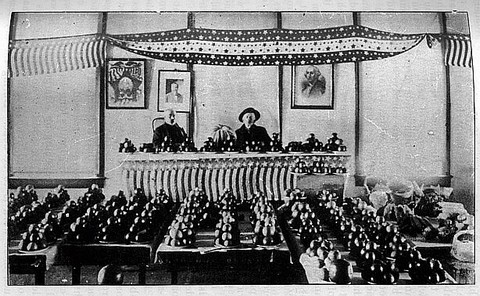
A creditable display. Much of Morgan county is well adapted to fruit growing.
[p.50]
the last three years has very materially decreased the acreage planted. Blue grass, clover, timothy and alfalfa are all important, and grow luxuriantly in their proper localities. (b) The fire clays of Morgan county are nothing short of wonderful. The white flint fire clay contains 42.45 per cent alumina, and has the highest alumina content of any clay in the United States. In combination with the white plastic clays found here in abundance, these flint clays make the finest fire brick to be found, brick which will stand 3,200 degrees of heat. In addition to the manufacture of fire brick, a high grade of pottery is made from the plastic clays. (c) Morgan county stands second in the production of crude barytes, which is largely used in the manufacture of paints. (d) The grazing section of the county, i.e., that portion lying south of the Rock Island railroad, is coming into prominence as a stock country. Watered by hundreds of springs and abounding in luxuriant native grass, it is more and more attracting the attention of stockmen from all sections of the country. This hill land can yet be bought for from $7 to $15 per acre, depending on location and improvements. (e) Morgan county produces many other articles of commerce, such as railroad ties, mine props, ax handles, telephone pins and brackets, lead, zinc, and cannel coal.
Transportation—The county is traversed from east to west by the St. Louis-Kansas City line of the Rock Island, and a branch of the Missouri Pacific runs from Tipton to Versailles. There is also a "plug" road, five miles in length, running from Versailles to one of the big fire clay plants.
Roads—Morgan county has 79 miles of county-seat to county-seat road. There are about 35 miles of graveled road, mostly leading out from Versailles. There is no doubt about the public spirit of Morgan county people when it comes to good roads. In April, 1914, a company of 70 men was formed for the purchase of an up-to-date road-building machine. A gasoline tractor of 80-horsepower drawing capacity, a "scarifier," and three large graders were purchased. This outfit cost $5,000 cash, and with it a road 20 miles long was graded "toward the hill country of Judea," opening up a large section between Versailles and Linn Creek. In addition to grading this 20 miles, other roads were graded and put in first-class shape and much more work is to be done. During the dry season automobiles can easily go from Versailles to Linn Creek and along the Osage River. Many people have availed themselves of this fine trip.
[p.51]
"The South Country"—Leaving Versailles one enters almost immediately into the timbered section. This is the rough part of the country, and is the sport section—the beginning of the Ozark uplift. Here are found wonderful caves, magnificent springs, clear streams—streams where the wily black bass sports in the indigo-blue water, all of which is a sportman's paradise. Here one sees those magnificent hills which inspired Harold Bell Wright, whose stories of the Ozarks have become classics. Here one finds the descendants of the earliest pioneers of America—a people undefiled by later immigration—the purest Anglo-Saxon in the western continent. The most wonderful sensation of music the writer ever experienced was on being awakened in the early morning by a bird concert; nothing can describe the babel of voices and the sweet strains of these beautiful singers of the hills.
General Remarks—Among the most prosperous farmers of the county are the Mennonites, who have a large settlement northeast of the county. There are many prosperous stock-raisers and feeders in this part of the county. Hundreds of cattle, sheep and hogs are annually brought out of the hills and fed for market. There are three live newspapers in the county, The Statesman, Leader and Stover News, the last named being published in the progressive little village of Stover. The banking interests are well represented by safe and conservative banks, well managed, and with ample resources to care for the needs of the different communities where they are located. We have not mentioned the excellent school system of the county for the reason that this subject is fully taken care of by our progressive Superintendent of Schools.
[p.52]
Source: Missouri State Board of Agriculture Monthly Bulletin, Vol. XIV, No. 2 (February, 1916): A Rural Survey of Morgan County Missouri. Digital version © 2001 Peter Binkley; permission to reproduce for non-commercial purposes is granted.